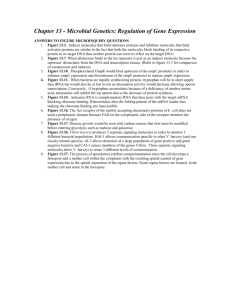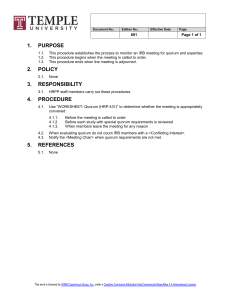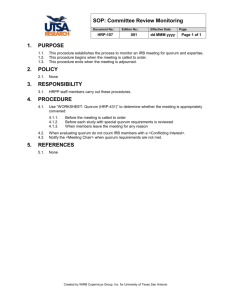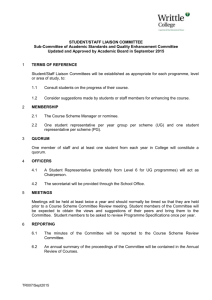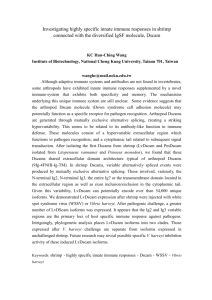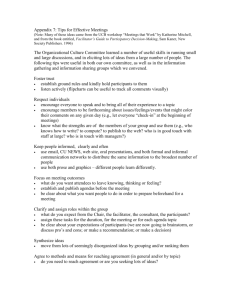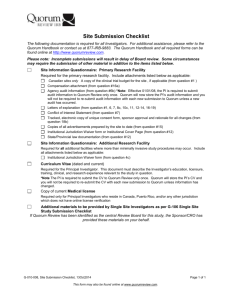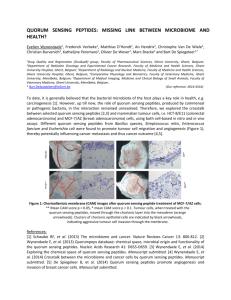The natural furanone (5Z)-4-bromo-5- (bromomethylene)-3-butyl
advertisement
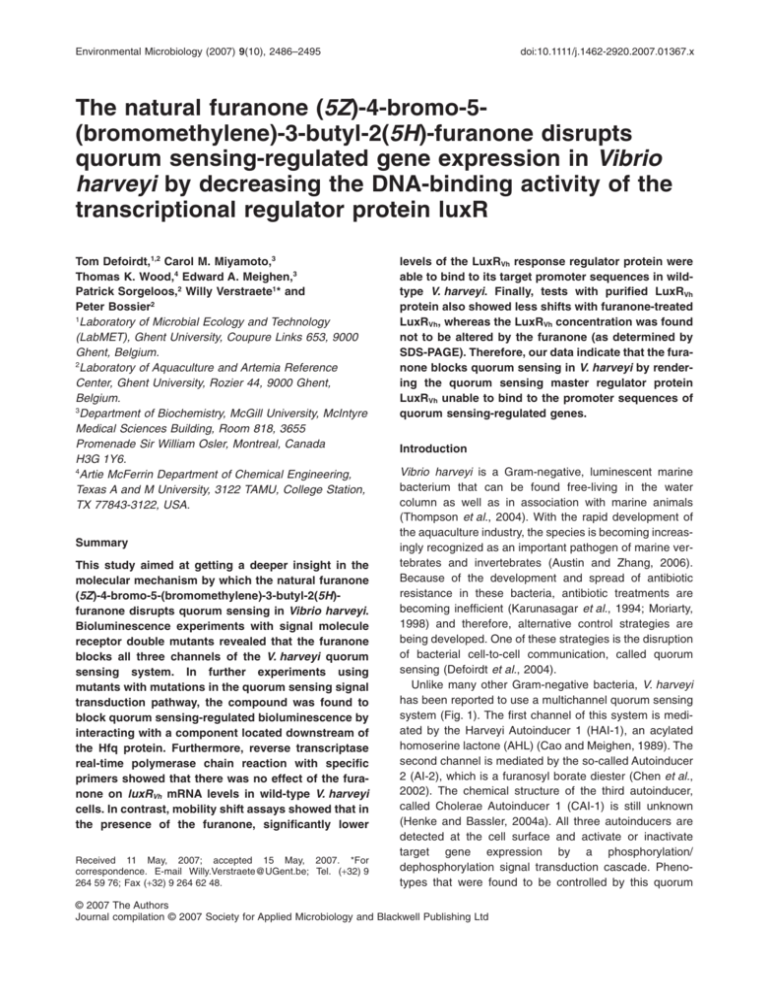
Environmental Microbiology (2007) 9(10), 2486–2495 doi:10.1111/j.1462-2920.2007.01367.x The natural furanone (5Z)-4-bromo-5(bromomethylene)-3-butyl-2(5H)-furanone disrupts quorum sensing-regulated gene expression in Vibrio harveyi by decreasing the DNA-binding activity of the transcriptional regulator protein luxR Tom Defoirdt,1,2 Carol M. Miyamoto,3 Thomas K. Wood,4 Edward A. Meighen,3 Patrick Sorgeloos,2 Willy Verstraete1* and Peter Bossier2 1 Laboratory of Microbial Ecology and Technology (LabMET), Ghent University, Coupure Links 653, 9000 Ghent, Belgium. 2 Laboratory of Aquaculture and Artemia Reference Center, Ghent University, Rozier 44, 9000 Ghent, Belgium. 3 Department of Biochemistry, McGill University, McIntyre Medical Sciences Building, Room 818, 3655 Promenade Sir William Osler, Montreal, Canada H3G 1Y6. 4 Artie McFerrin Department of Chemical Engineering, Texas A and M University, 3122 TAMU, College Station, TX 77843-3122, USA. Summary This study aimed at getting a deeper insight in the molecular mechanism by which the natural furanone (5Z)-4-bromo-5-(bromomethylene)-3-butyl-2(5H)furanone disrupts quorum sensing in Vibrio harveyi. Bioluminescence experiments with signal molecule receptor double mutants revealed that the furanone blocks all three channels of the V. harveyi quorum sensing system. In further experiments using mutants with mutations in the quorum sensing signal transduction pathway, the compound was found to block quorum sensing-regulated bioluminescence by interacting with a component located downstream of the Hfq protein. Furthermore, reverse transcriptase real-time polymerase chain reaction with specific primers showed that there was no effect of the furanone on luxRVh mRNA levels in wild-type V. harveyi cells. In contrast, mobility shift assays showed that in the presence of the furanone, significantly lower Received 11 May, 2007; accepted 15 May, 2007. *For correspondence. E-mail Willy.Verstraete@UGent.be; Tel. (+32) 9 264 59 76; Fax (+32) 9 264 62 48. levels of the LuxRVh response regulator protein were able to bind to its target promoter sequences in wildtype V. harveyi. Finally, tests with purified LuxRVh protein also showed less shifts with furanone-treated LuxRVh, whereas the LuxRVh concentration was found not to be altered by the furanone (as determined by SDS-PAGE). Therefore, our data indicate that the furanone blocks quorum sensing in V. harveyi by rendering the quorum sensing master regulator protein LuxRVh unable to bind to the promoter sequences of quorum sensing-regulated genes. Introduction Vibrio harveyi is a Gram-negative, luminescent marine bacterium that can be found free-living in the water column as well as in association with marine animals (Thompson et al., 2004). With the rapid development of the aquaculture industry, the species is becoming increasingly recognized as an important pathogen of marine vertebrates and invertebrates (Austin and Zhang, 2006). Because of the development and spread of antibiotic resistance in these bacteria, antibiotic treatments are becoming inefficient (Karunasagar et al., 1994; Moriarty, 1998) and therefore, alternative control strategies are being developed. One of these strategies is the disruption of bacterial cell-to-cell communication, called quorum sensing (Defoirdt et al., 2004). Unlike many other Gram-negative bacteria, V. harveyi has been reported to use a multichannel quorum sensing system (Fig. 1). The first channel of this system is mediated by the Harveyi Autoinducer 1 (HAI-1), an acylated homoserine lactone (AHL) (Cao and Meighen, 1989). The second channel is mediated by the so-called Autoinducer 2 (AI-2), which is a furanosyl borate diester (Chen et al., 2002). The chemical structure of the third autoinducer, called Cholerae Autoinducer 1 (CAI-1) is still unknown (Henke and Bassler, 2004a). All three autoinducers are detected at the cell surface and activate or inactivate target gene expression by a phosphorylation/ dephosphorylation signal transduction cascade. Phenotypes that were found to be controlled by this quorum © 2007 The Authors Journal compilation © 2007 Society for Applied Microbiology and Blackwell Publishing Ltd Mode of action of brominated furanone in Vibrio harveyi A CAI-1 AI-2 HAI-1 B HAI-1 AI-2 LuxP LuxQ LuxN P 2487 CAI-1 LuxP CqsS LuxS LuxN P P LuxM LuxQ P CqsA CqsS LuxS P P LuxM CqsA LuxU LuxU PP P LuxO σ LuxO 54 sRNAs + Hfq LuxRVh σ 54 sRNAs + Hfq Target genes LuxRVh Fig. 1. Quorum sensing in Vibrio harveyi. The LuxM, LuxS and CqsA enzymes synthesize the autoinducers HAI-1, AI-2 and CAI-1 respectively. These autoinducers are detected at the cell surface by the LuxN, LuxP-LuxQ and CqsS receptor proteins respectively. A. At low signal molecule concentration, the receptors autophosphorylate and transfer phosphate to LuxO via LuxU. Phosphorylation activates LuxO, which together with s54 activates the production of small regulatory RNAs (sRNAs). These sRNAs, together with the chaperone Hfq, destabilize the mRNA encoding the response regulator LuxRVh. Therefore, in the absence of autoinducers, the LuxRVh protein is not produced. B. In the presence of high concentrations of the autoinducers, the receptor proteins switch from kinases to phosphatases, which results in dephosphorylation of LuxO. Dephosphorylated LuxO is inactive and therefore, the sRNAs are not formed and the response regulator LuxRVh is produced (adapted from Henke and Bassler, 2004a). sensing system include bioluminescence (Bassler et al., 1993) and the production of several virulence factors such as a type III secretion system (Henke and Bassler, 2004b), extracellular toxin (Manefield et al., 2000) and a siderophore (Lilley and Bassler, 2000). Recently, we found that virulence of the bacterium towards the brine shrimp Artemia franciscana is also regulated by its quorum sensing system (Defoirdt et al., 2005). One of the mechanisms to disrupt bacterial quorum sensing is the use of halogenated furanones, such as the natural furanone (5Z)-4-bromo-5-(bromomethylene)-3butyl-2(5H)-furanone. These furanones (natural occurring compounds as well as synthetic derivatives) were found to disrupt the expression of different AHL-regulated phenotypes in several Gram-negative species, without affecting their growth (Hentzer and Givskov, 2003; Rasmussen and Givskov, 2006). Because of the structural similarity between AHL molecules and the furanones, it was originally hypothesized that these compounds disrupt AHLmediated quorum sensing in the LuxI/LuxRVf-type of quorum sensing system by competitively binding to the AHL receptor site of the Vibrio fischeri LuxRVf protein (Givskov et al., 1996). Later on, it was shown that the halogenated furanones promote rapid turnover of the LuxRVf-type AHL receptor protein, reducing the amount of LuxRVf available to interact with AHL and to act as transcriptional regulator (Manefield et al., 2002). More recently, Koch and colleagues (2005) used site-directed mutagenesis to study interactions between LuxRVf and halogenated furanones. The authors could not conclude that the furanones bind to the AHL-binding cavity and suggested that furanones do not compete in a classic way with the signal molecules. Meanwhile, several research groups provided evidence that halogenated furanones also disrupt quorum sensingregulated gene expression in V. harveyi (Manefield et al., 2000; Ren et al., 2001; McDougald et al., 2003; Defoirdt et al., 2006). However, because the quorum sensing system of V. harveyi is quite different from the LuxI/LuxRVftype of quorum sensing system and does not contain a LuxRVf homologue (Milton, 2006), the molecular mechanism of quorum sensing disruption in this species must be different from that in the LuxI/LuxRVf-type of system. Consequently, in this study, we aimed at defining the molecular mechanism by which the natural furanone (5Z)-4-bromo5-(bromomethylene)-3-butyl-2(5H)-furanone (Fig. 2) disrupts quorum sensing-regulated gene expression in this different type of quorum sensing system. O O Br Br H3C Fig. 2. Structure of the natural furanone used in this study. © 2007 The Authors Journal compilation © 2007 Society for Applied Microbiology and Blackwell Publishing Ltd, Environmental Microbiology, 9, 2486–2495 2488 T. Defoirdt et al. 1e+7 1e+6 1e+5 1e+4 1e+3 0.0 0.5 1.0 1.5 2.0 2.5 Time (h) Fig. 3. Bioluminescence per unit cell density in wild-type Vibrio harveyi BB120 as a function of time, without (open symbols) and with (filled symbols) the natural furanone (5Z)-4-bromo-5(bromomethylene)-3-butyl-2(5H)-furanone (50 mg l-1). The error bars represent the standard deviation of three replicates. Note that RLU is the relative unit of luminescence reported by the Lumac Biocounter M2500 luminometer. Results Impact of the furanone on quorum sensing-regulated bioluminescence of wild-type V. harveyi Bioluminescence is one of the phenotypes that is regulated by the V. harveyi quorum sensing system and therefore, in a first experiment, the impact of the natural furanone (5Z)-4-bromo-5-(bromomethylene)-3butyl-2(5H)-furanone on the bioluminescence of wild-type V. harveyi was determined. Strain BB120 was grown in LB20 medium to high cell density in order to activate quorum sensing-regulated bioluminescence, after which the furanone was added to the medium at 50 mg l-1. The compound blocked bioluminescence of BB120, with over 3 log units difference between the furanone-treated and the untreated cultures already 0.5 h after the addition of the furanone (Fig. 3). Consistent with this, luciferase activity in protein lysates of furanone-treated BB120 cells was found to have decreased with approximately 1 log unit 0.5 h after the addition of 50 mg l-1 furanone (Fig. 4). The bacterial alkaline phosphatase activities of the protein lysates were also measured in order to verify that the furanone had no effect on phenotypes that are not regulated by the quorum sensing system. As expected, there was no significant difference in bacterial alkaline phosphatase activities between furanone-treated and untreated cells (Fig. 4). Impact of the furanone on bioluminescence of constitutively luminescent V. harveyi mutants with mutations in the quorum sensing signal transduction cascade Because the three signal molecules have quite different chemical structures (Henke and Bassler, 2004a), we suspected that the furanone did not block quorum sensingregulated bioluminescence by competing with the autoinducers for receptor sites but rather by interfering with the quorum sensing signal transduction. In order to test this hypothesis, the effects of the furanone on bioluminescence of mutants that were fixed in the high cell-density configuration at different stages in the quorum sensing signal transduction cascade were investigated. The mutants JAF553 and JAF483 contain a point mutation in the luxU and luxO genes, respectively, that render the LuxU and LuxO proteins incapable of phosphorelay (Freeman and 1000 protein) 1e+8 the impact of the furanone on the different channels, the signal molecule receptor double mutants JAF375 (sensor HAI-1–, sensor AI-2–, sensor CAI-1+), JMH597 (sensor HAI-1–, sensor AI-2+, sensor CAI-1–) and JMH612 (sensor HAI-1+, sensor AI-2–, sensor CAI-1–) were used. Because of the mutated receptors, bioluminescence in these mutants is only responsive to one of the three signal molecules (Henke and Bassler, 2004a). The mutants were grown to high cell densities, and after furanone addition, bioluminescence was found to be blocked in all three double mutants in a concentration-dependent way similar to the one obtained for the wild type (Fig. 5). This indicates that all three channels of the quorum sensing system were blocked. Enzyme activity (U mg Biolouminescence (RLU/OD600) 1e+9 100 10 1 0.0 0.5 1.0 1.5 2.0 Time (h) Impact of the furanone on bioluminescence of V. harveyi autoinducer receptor double mutants The V. harveyi quorum sensing system consists of three channels, with each channel being activated by a different type of signal molecule (Fig. 1). In order to determine Fig. 4. Luciferase (circles) and bacterial alkaline phosphatase (triangles) activities in protein lysates of wild-type Vibrio harveyi BB120 as a function of time, without (open symbols) and with (filled symbols) the natural furanone (5Z)-4-bromo-5-(bromomethylene)3-butyl-2(5H)-furanone (50 mg l-1). The error bars represent the standard deviation of four independent experiments. © 2007 The Authors Journal compilation © 2007 Society for Applied Microbiology and Blackwell Publishing Ltd, Environmental Microbiology, 9, 2486–2495 Mode of action of brominated furanone in Vibrio harveyi reverse transcriptase real-time polymerase chain reaction (PCR) with specific primers and the RNA polymerase A subunit (rpoA) mRNA was analysed as a control of a non-quorum sensing-regulated gene. For both genes, the mRNA levels followed a similar trend, with no significant difference between furanone-treated and untreated cells (Fig. 7). From these results, we conclude that the furanone has no effect on luxRVh mRNA levels. 140 120 80 60 40 0 0.01 BB120 (Wildtype) JAF375 (CAI-1) JMH597 (AI-2) JMH612 (HAI-1) 0.1 1e+8 1 10 100 1000 [Furanone] (mg l–1) Fig. 5. Bioluminescence of the Vibrio harveyi wild type (BB120) and the double mutants JAF375 (sensor HAI-1–, sensor AI-2–, sensor CAI-1+), JMH597 (sensor HAI-1–, sensor AI-2+, sensor CAI-1–) and JMH612 (sensor HAI-1+, sensor AI-2–, sensor CAI-1–) as a function of the concentration of the natural furanone (5Z)-4-bromo-5-(bromomethylene)-3-butyl-2(5H)-furanone. Luminescence measurements were performed 0.5 h after the addition of the furanone. For each strain, the bioluminescence without the addition of furanone was set at 100% and the other samples were normalized accordingly. The error bars represent the standard deviation of three replicates. Bioluminescence (RLU/OD600) Bioluminescence (%) 100 20 2489 1e+7 1e+6 1e+5 1e+4 553 JAF U) (Lux 483 JAF O) (Lux fq) (H 258 BNL Fig. 6. Bioluminescence of wild-type Vibrio harveyi BB120 and the mutants JAF553 (luxU H58A), JAF483 (luxO D47A) and BNL258 (hfq::Tn5lacZ) without (white bars) and with (striped bars) the natural furanone (5Z)-4-bromo-5-(bromomethylene)-3-butyl-2(5H)furanone (50 mg l-1). Measurements were performed 0.5 h after the addition of the furanone. The error bars represent the standard deviation of three replicates. Note that RLU is the relative unit of luminescence reported by the Lumac Biocounter M2500 luminometer. 2 log(difference in [mRNA]) Bassler, 1999a,b). Strain BNL258 has a Tn5 insertion in the hfq gene, resulting in a non-functional Hfq protein (Lenz et al., 2004). Hence, because of the nature of these mutations, the three mutants are constitutively luminescent and therefore, blocking luminescence in one of them would indicate that the furanone acts downstream of the mutated component. The furanone, at 50 mg l-1, blocked luminescence in all three mutants (Fig. 6). In wild-type V. harveyi, the Hfq protein acts together with small regulatory RNAs to destabilize the mRNA of the master regulator LuxRVh (see Fig. 1). In the mutant BNL258, a transposon insertion has rendered the Hfq protein non-functional and therefore, in this mutant, the luxRVh mRNA cannot be destabilized by the quorum sensing signal transduction system, resulting in a constitutively expressed bioluminescence (Lenz et al., 2004). The fact that the furanone blocked bioluminescence in this mutant indicates that it acts downstream of Hfq, i.e. at the level of the luxRVh mRNA and/or the LuxRVh protein. pe) ildty 0 (w B12 1 0 -1 Impact of the furanone on luxRVh mRNA levels -2 In order to verify whether the furanone indeed affects the quorum sensing master regulator, an experiment was set up in which the impact of the addition of the compound on luxRVh mRNA was studied. Wild-type V. harveyi BB120 was grown to high cell density, after which the natural furanone was added at 50 mg l-1. The addition of the furanone resulted in a rapid decrease in luminescence (Fig. 3). luxRVh mRNA levels were quantified relatively by 0.0 0.5 1.0 1.5 2.0 2.5 Time (h) Fig. 7. Difference in luxRVh (filled symbols) and rpoA (open symbols) mRNA levels between wild-type Vibrio harveyi BB120 cells treated with the natural furanone (5Z)-4-bromo-5(bromomethylene)-3-butyl-2(5H)-furanone (50 mg l-1) and untreated cells, as determined by reverse transcriptase real-time PCR with specific primers. The error bars represent the standard deviation of two independent experiments. © 2007 The Authors Journal compilation © 2007 Society for Applied Microbiology and Blackwell Publishing Ltd, Environmental Microbiology, 9, 2486–2495 2490 T. Defoirdt et al. 0.5h 2 1h 3 2h 4 0h 5 0.5h 6 1h 7 2h 8 Blank 9 C -F ur an on e +F ur an on e 0h 1 + Furanone la dd er B - Furanone -F ur an +F one ur an on e A LuxR Fig. 8. LuxRVh DNA binding as determined by mobility shifts. A. Autoradiograph after 5% polyacrylamide gel electrophoresis of 5′ 32P-labelled luxRVh promoter DNA containing the LuxRVh binding sites, mixed with 0.5 mg of protein lysates from wild-type Vibrio harveyi BB120: lanes 1–4, addition of lysates taken at different time points from an untreated culture; lanes 5–8, addition of lysates taken at different time points from a culture treated with 50 mg l-1 of the natural furanone (5Z)-4-bromo-5-(bromomethylene)-3-butyl-2(5H)-furanone; last lane, blank (addition of lysate from the luxR-negative strain MR1130). B. Autoradiograph after 5% polyacrylamide gel electrophoresis of 5′ 32P-labelled luxRVh promoter DNA containing the LuxRVh binding sites, mixed with purified LuxRVh, which was incubated in vitro for 1 h with or without the furanone (50 mg l-1). C. SDS-PAGE of the same samples as in panel B. Impact of the furanone on LuxRVh protein levels and LuxRVh binding to its target promoter sequences Mobility shifts using radiolabelled luxRVh promoter DNA containing the LuxRVh binding sites showed less shifts with cell lysates from furanone-treated cells when compared with untreated cells (Fig. 8A), indicating that there were significantly lower levels of the protein able to bind the promoter DNA. In order to quantify the difference in bound LuxRVh levels between furanone-treated and untreated cells, a titration for mobility shifts of luxRVh promoter DNA using the 2-h samples was performed. This titration revealed that 0.025 mg lysate of untreated cells gave the same shift as 0.5 mg lysate of furanone-treated cells (data not shown), which indicates that there was a 20-fold difference in LuxRVh levels bound to the promoter DNA. The luxCDABEGH promoter DNA was also used to check for LuxRVh shifts, with similar findings (Fig. 9). These observations could be explained by the furanone either decreasing translation or increasing turnover of LuxRVh, or altering the protein in such a way that it is rendered unable to bind to its target promoter. Some additional tests were performed to clear this up. First, 50 mg l-1 chloramphenicol was added to V. harveyi BB120 cultures in order to stop translation of LuxRVh. In these cultures, there was no effect on LuxRVh mobility shifts in the absence of furanone throughout the 1 h of incubation, whereas in the presence of furanone, again less shifts occurred (data not shown). This suggests that LuxRVh has quite a slow turnover and that the furanone acts on pre-existing LuxRVh. Finally, the furanone was added to purified LuxRVh, and after subsequent incubation of the mixture, again significantly lower levels of LuxRVh were found to bind to the promoter DNA when compared with untreated LuxRVh (Fig. 8B). Interestingly, SDS-PAGE showed that the concentration of LuxRVh in the mixtures was not affected by the furanone (Fig. 8C). Together, these data lead to the conclusion that the furanone compound renders LuxRVh unable to bind to its target promoter sequences, without degrading the protein. Discussion Disease caused by antibiotic resistant luminescent vibrios is a serious problem in the aquaculture industry (Austin and Zhang, 2006). Recent investigations have pointed out © 2007 The Authors Journal compilation © 2007 Society for Applied Microbiology and Blackwell Publishing Ltd, Environmental Microbiology, 9, 2486–2495 Mode of action of brominated furanone in Vibrio harveyi - Furanone + Furanone 0h 0.5h 1h 2h 0h 0.5h 1h 2h 1 2 3 4 5 6 7 8 Blank 9 Fig. 9. LuxRVh DNA binding as determined by mobility shifts. Autoradiograph after 5% polyacrylamide gel electrophoresis of 5′ 32 P-labelled luxCDABEGH promoter DNA containing the LuxRVh binding sites, mixed with 0.5 mg of protein lysates from wild-type Vibrio harveyi BB120: lanes 1–4, addition of lysates taken at different time points from an untreated culture; lanes 5–8, addition of lysates taken at different time points from a culture treated with 50 mg l-1 of the natural furanone (5Z)-4-bromo-5-(bromomethylene)3-butyl-2(5H)-furanone; last lane, blank (addition of lysate from the luxR-negative strain MR1130). that disruption of the quorum sensing system of these bacteria by using halogenated furanones could be a promising alternative biocontrol strategy (Manefield et al., 2000; Defoirdt et al., 2006). In view of the potential practical applications of this type of compounds, it is of significant interest to define the mode of action of the furanones in these bacteria. Hence, in this study, we aimed at elucidating the molecular mechanism of quorum sensing disruption by the natural furanone (5Z)-4-bromo-5(bromomethylene)-3-butyl-2(5H)-furanone in V. harveyi. In a first series of experiments, the impact of the natural furanone (5Z)-4-bromo-5-(bromomethylene)-3-butyl2(5H)-furanone on quorum sensing-regulated bioluminescence of V. harveyi wild type and quorum sensing mutants was determined. Importantly, halogenated furanones were shown before not to block bioluminescence when expressed from an external promoter (Givskov et al., 1996), indicating that the biochemical function of the Lux proteins is not affected. Consistent with the work of Manefield and colleagues (2000), the compound was found to 2491 block bioluminescence in wild-type V. harveyi BB120 in a concentration-dependent way. Moreover, luciferase activity was significantly decreased in protein lysates of furanone-treated BB120 cells. In order to determine the effect of the furanone on the three different channels of the V. harveyi quorum sensing system, its impact on bioluminescence of the signal molecule receptor double mutants JAF375, JMH597 and JMH612 (Henke and Bassler, 2004a) was studied. The compound was shown to block bioluminescence in all three double mutants in a pattern similar to the one obtained for the wild type. Because of the mutated receptors, bioluminescence in these mutants is only responsive to one of the three signal molecules, which implies that all three channels of the quorum sensing system were blocked. These data confirm the reports by Ren and colleagues (2001) and McDougald and colleagues (2003), who determined the impact of the furanone on the AI-2- and/or HAI-1mediated channels of the system by using the AI-2 and/or HAI-1 receptor mutants BB886 and BB170 (which thus were still responsive to both HAI-1 and CAI-1 and AI-2 and CAI-1 respectively). Moreover, our results indicate that the furanone also blocks the CAI-1-mediated channel of the V. harveyi quorum sensing system. Previously, the hypothesis that prevailed in literature was that the furanones disrupt quorum sensing in V. harveyi by displacing the signal molecules from their receptors (Manefield et al., 2000; Ren et al., 2001). However, because the three signal molecules have quite different chemical structures (although the exact structure of CAI-1 is still unknown; Henke and Bassler, 2004a), we suspected that the furanone did not block quorum sensing-regulated bioluminescence by competing with the autoinducers for receptor sites but rather by interfering with the quorum sensing signal transduction. In order to test this hypothesis, the effects of the furanone on bioluminescence of mutants that were fixed in the high celldensity configuration at different stages in the quorum sensing signal transduction cascade were investigated (i.e. LuxU, LuxO and Hfq). We found that the furanone blocked bioluminescence in the hfq mutant BNL258. Hfq is a chaperone protein that acts together with small regulatory RNAs to destabilize the mRNA of the master regulator LuxRVh. The Hfq protein is non-functional in strain BNL258, resulting in constitutively expressed bioluminescence (Lenz et al., 2004). The fact that the furanone blocked bioluminescence in this mutant indicates that it acts downstream of Hfq, i.e. at the level of the luxRVh mRNA and/or the LuxRVh protein and not by displacing the signal molecules from their receptors. The quorum sensing master regulator protein LuxRVh has been shown before to be a transcriptional activator that is required for expression of the lux operon (Swartzman et al., 1992; Swartzman and Meighen, 1993). © 2007 The Authors Journal compilation © 2007 Society for Applied Microbiology and Blackwell Publishing Ltd, Environmental Microbiology, 9, 2486–2495 2492 T. Defoirdt et al. Consequently, in a final series of experiments, the effect of the furanone on this response regulator protein was investigated. Reverse transcriptase real-time PCR with primers specific for V. harveyi luxRVh revealed that the furanone has no effect on the concentration of the luxRVh mRNA. In contrast, mobility shift assays showed that the concentration of the LuxRVh response regulator protein able to bind to its target promoter sequences significantly decreased after furanone addition, both in intact cells and in purified LuxRVh extracts. Interestingly, the concentration of the LuxRVh protein was shown not to be affected by the furanone (as determined by SDS-PAGE analysis). LuxRVh is a member of the TetR family of transcriptional regulators containing a helix–turn–helix DNA binding domain (Ramos et al., 2005). Members of the TetR family that have been studied in depth, have been shown to bind DNA as dimers, but this has not yet been proven for LuxRVh. Because halogenated furanones are known to be very reactive compounds (Hentzer and Givskov, 2003), we hypothesize that the furanone reacts with the LuxRVh protein, thereby altering it in such a way that it cannot bind the DNA anymore, either by changing the structure of the DNA binding domain or the regions involved in dimer formation (that is, if LuxRVh also needs to dimerize in order to bind DNA). However, the elucidation of the exact biochemical reaction mechanism between halogenated furanones and LuxRVh (with the aid of mass spectrometry) will be part of future work at our laboratories. The fact that the furanone affects the master regulator rather than selectively blocking one of the channels of the V. harveyi quorum sensing system is quite important with respect to possible practical applications because there seems to be a difference in the relative importance of the three channels for a successful infection of different hosts. Indeed, disrupting only the AI-2-mediated channel of the V. harveyi quorum sensing system has been shown to significantly increase survival of the brine shrimp A. franciscana, whereas the HAI-1-mediated channel had no effect on infection of the shrimp (Defoirdt et al., 2005). In contrast, both the HAI-1- and AI-2mediated channel needed to be disrupted in order to decrease mortality of gnotobiotic rotifers (Brachionus plicatilis) caused by V. harveyi (Tinh et al., 2007). Because the furanone blocks all three channels of the system at once by acting at the end of the quorum sensing signal transduction cascade, it will not be necessary to develop different furanone compounds to protect different hosts. Consistent with this, the natural furanone was shown to protect both brine shrimp and rotifers from luminescent vibrios (Defoirdt et al., 2006; Tinh et al., 2007). In addition to this, several human pathogens, including Vibrio cholerae, Vibrio parahaemolyticus and Vibrio vulnificus, have been found to contain a LuxRVh homologue (Jobling and Holmes, 1997; McCarter, 1998; McDougald et al., 2000). Moreover, the LuxRVh homologues have been shown before to regulate virulence factor production in these species as well (Henke and Bassler, 2004b; Milton, 2006) and consequently, the furanones might be useful to control infections caused by these human pathogens. In addition to affecting both V. fischeri LuxRVf (Manefield et al., 2002) and V. harveyi LuxRVh (this study), covalent binding of this natural furanone to the Escherichia coli LuxS protein has been reported (Ren et al., 2004). Hence, it can be hypothesized that these furanones react with certain reactive groups which are present in different regulatory proteins. It therefore seems that the macro-alga Delisea pulchra has evolved a sophisticated quorum sensing disruption-based defence system, producing compounds that affect different types of signal regulators in a non-growth inhibitory way. In view of the broad range of bacteria that can potentially colonize marine organisms, the production of broad spectrum quorum sensing-disrupting compounds by the alga probably confers a strong evolutionary advantage. In conclusion, the results presented in this article show that the natural furanone (5Z)-4-bromo-5(bromomethylene)-3-butyl-2(5H)-furanone disrupts quorum sensing-regulated gene expression in V. harveyi by decreasing the DNA-binding activity of the quorum sensing master regulator protein LuxRVh. These results are of significant practical interest because they suggest that the furanone could be used as a broad spectrum biocontrol agent to protect a variety of hosts from different pathogenic vibrios in which virulence factor production is regulated by a LuxRVh homologue. Experimental procedures Furanone preparation The natural furanone (5Z)-4-bromo-5-(bromomethylene)-3butyl-2(5H)-furanone was synthesized as described previously (Ren et al., 2001). The furanone was dissolved and diluted in pure ethanol and stored at -20°C. Bacterial strains and growth conditions The strains that were used in this study are shown in Table 1. All strains were grown in Luria–Bertani medium containing 20 g l-1 NaCl (LB20) at 28°C under constant agitation. Spectrophotometry at OD600 was used to measure growth. Luminescence was measured with a Lumac Biocounter M2500 luminometer (Lumac b.v., Landgraaf, the Netherlands). For all experiments, V. harveyi strains were grown to an OD600 of approximately 0.75, after which the furanone was added to the cultures in the appropriate concentration and the cultures were further incubated at 28°C with shaking. Unless otherwise indicated, samples were taken in triplicate 0.5 h after furanone addition. © 2007 The Authors Journal compilation © 2007 Society for Applied Microbiology and Blackwell Publishing Ltd, Environmental Microbiology, 9, 2486–2495 Mode of action of brominated furanone in Vibrio harveyi 2493 Table 1. Strains used in this study. Strain Phenotype Reference Vibrio harveyi BB120 Wild type from which strains BNL258, JAF375, JAF483, JAF553, JMH597 and JMH612 are derived hfq::Tn5lacZ luxN::CmR luxQ::KanR luxO D47A linked to KanR luxU H58A linked to KanR luxN::Tn5 cqsS::CmR luxPQ::Tn5 cqsS::CmR Isogenic LuxR mutant Bassler et al. (1997) Vibrio Vibrio Vibrio Vibrio Vibrio Vibrio Vibrio harveyi harveyi harveyi harveyi harveyi harveyi harveyi BNL258 JAF375 JAF483 JAF553 JMH597 JMH612 MR1130 Protein assays Wild-type V. harveyi BB120 was used in the luciferase and bacterial alkaline phosphatase assays. Immediately before and 0.5, 1 and 2 h after the addition of the furanone, 2 units [OD600 ¥ vol (ml)] were pelleted, sonicated in 0.5 ml of 0.25 M Tris, pH 8 and the cellular debris removed (as described by Miyamoto et al., 1990). A modified Lowry assay was used to determine the protein content (Markwell et al., 1981). In vitro luciferase and bacterial alkaline phosphatase activities were determined as described by Gunsalus-Miguel and colleagues (1972) and Garen and Levinthal (1960). Primer design Specific primers for the amplification of luxRVh and RNA polymerase A subunit (rpoA) mRNA were designed using the Primer Express 2.0 software (Applied Biosystems, Foster City, USA). The primers were designed based on the consensus of the sequences that have been deposited before in GenBank. The combinations of the two primer sequences were blasted against GenBank. The primer sequences are shown in Table 2. RNA extraction and reverse transcriptase real-time PCR The effect of the furanone on luxRVh mRNA concentrations was studied in wild-type V. harveyi BB120. Immediately before and 0.5, 1 and 2 h after furanone addition, luminescence and cell density (OD600) of the cultures were measured and 0.5 ml of samples for RNA extraction were taken, which were immediately frozen in cold ethanol (-80°C). RNA was isolated using the Qiagen RNeasy Mini Kit (Qiagen, Hilden, Germany) according to the manufacturer’s instructions. RNA extracts were treated with RNAse-free DNAse I (Fermentas, St. Leon-Rot, Germany), after which the RNA quantity was checked spectrophotometrically. RNA concentrations obtained were all around 300 ng ml-1. RNA quality was confirmed by electrophoresis. cDNA was obtained by reverse Table 2. Primers used in this study. Target Primer Sequence rpoA rpoAforward rpoAreverse 5′-CGTAGCTGAAGGCAAAGATGA-3′ 5′-AAGCTGGAACATAACCACGA-3′ luxRVh LuxRforward LuxRreverse 5′-TCAATTGCAAAGAGACCTCG-3′ 5′-AGCAAACACTTCAAGAGCGA-3′ Lenz et al. (2004) Freeman and Bassler (1999a) Freeman and Bassler (1999a) Freeman and Bassler (1999b) Henke and Bassler (2004a) Henke and Bassler (2004a) Martin et al. (1989) transcription using the Qiagen One Step RT-PCR kit (Qiagen), according to the manufacturer’s instructions. Real-time PCR was performed with the specific luxRVh and rpoA primers. Amplicon lengths are 84 bp and 197 bp for luxRVh and rpoA respectively. Amplification was performed in 25 ml reaction mixtures using the SYBR Green PCR Master Mix kit (Applied Biosystems, Nieuwerkerk a/d Ijssel, the Netherlands), according to the manufacturer’s instructions, in optical 96-well reaction plates with optical caps (Applied Biosystems). The thermal profile was as follows: 50°C for 2 min and 95°C for 10 min followed by 40 cycles of 95°C for 30 s, 54°C for 1 min, and 60°C for 1 min. Amplicon dissociation curves were determined by constant fluorescent measurement during a final heating step at 60°C to 95°C at 0.1°C s-1 ramping speed. The melting temperatures for the amplicons were 77°C and 82°C for luxRVh and rpoA respectively. The template DNA in the reaction mixtures was amplified and monitored with an ABI Prism SDS 7000 instrument (Applied Biosystems). The difference in mRNA levels between furanone-treated and untreated extracts was calculated as follows: log (difference in concentration) = DCt/regression coefficient with DCt the difference in Ct value between furanone-treated and untreated extracts. The regression coefficients between log(concentration) and Ct value were determined by analysing a 10-fold dilution series of a V. harveyi BB120 DNA extract and were -3.380 (R 2 = 0.998) and -3.597 (R 2 = 0.993) for luxRVh and rpoA respectively. Mobility shift assays The effect of the furanone on LuxRVh protein concentrations was studied in wild-type V. harveyi BB120. Immediately before and 0.5, 1 and 2 h after the addition of the furanone, 2 units [OD600 ¥ vol (ml)] were pelleted, sonicated in 0.5 ml of 0.25 M Tris, pH 8 and the cellular debris removed (as described by Miyamoto et al., 1990). In the experiment that aimed at testing whether the furanone affected translation or acted on pre-existing translates, cultures were treated with 50 mg l-1 chloramphenicol Sigma-Aldrich (Bornem, Belgium) before furanone addition. Mobility shift assays were conducted as described previously (Swartzman and Meighen, 1993) using radiolabelled luxRVh promoter DNA (Chatterjee et al., 1996) or luxCDABEGH promoter DNA (Miyamoto et al., 1996) containing the LuxRVh binding sites. The amount of retarded DNA was quantified as described in Miyamoto and colleagues (1996) using a Fuji bioimage. © 2007 The Authors Journal compilation © 2007 Society for Applied Microbiology and Blackwell Publishing Ltd, Environmental Microbiology, 9, 2486–2495 2494 T. Defoirdt et al. Experiments with purified LuxRVh LuxRVh purification was carried out as described previously (Swartzman and Meighen, 1993). The purified LuxRVh was stored in 50 mM NaPO4, 300 mM NaCl, pH 8.0. The protein concentration (as determined by Bio-Rad protein assays) was 0.2 mg ml-1. To glass tubes containing 40 ml of the protein preparation, 0.2 ml of absolute ethanol or 0.2 ml of furanone (10 mg ml-1 in ethanol) were directly added. The tubes were incubated in a 37°C water bath for 1 h and then stored at 4°C. For mobility shift analyses, the samples were diluted 10-fold in storage buffer and 1 ml (0.02 mg) was assayed. For SDS-PAGE, 1 mg of protein was applied and 10% SDS-PAGE was performed according to Maniatis and colleagues (1982). Acknowledgements We thank Bonnie Bassler for generously providing us with the V. harveyi mutants. This work was supported by the ‘Instituut voor de aanmoediging van Innovatie door Wetenschap en Technologie in Vlaanderen’ (IWT Grant no. 33205), the ‘Fonds voor Wetenschappelijk Onderzoek’ (project no. G0230.02N), the National Institutes of Health (EB00387201A1) and the Canadian Institutes of Health Research (MT7672). References Austin, B., and Zhang, X.-H. (2006) Vibrio harveyi: a significant pathogen of marine vertebrates and invertebrates. Lett Appl Microbiol 43: 119–124. Bassler, B.L., Wright, M., Showalter, R.E., and Silverman, M.R. (1993) Intercellular signaling in Vibrio harveyisequence and function of genes regulating expression of luminescence. Mol Microbiol 9: 773–786. Bassler, B.L., Greenberg, E.P., and Stevens, A.M. (1997) Cross-species induction of luminescence in the quorumsensing bacterium Vibrio harveyi. J Bacteriol 179: 4043– 4045. Cao, J.G., and Meighen, E.A. (1989) Purification and structural identification of an autoinducer for the luminescence system of Vibrio harveyi. J Biol Chem 264: 21670–21676. Chatterjee, J., Miyamoto, C.M., and Meighen, E.A. (1996) Autoregulation of luxR: the Vibrio harveyi lux-operon activator functions as a repressor. Mol Microbiol 20: 415–425. Chen, X., Schauder, S., Potier, N., Van Dorsselaer, A., Pelczer, I., Bassler, B.L., and Hughson, F.M. (2002) Structural identification of a bacterial quorum-sensing signal containing boron. Nature 415: 545–549. Defoirdt, T., Boon, N., Bossier, P., and Verstraete, W. (2004) Disruption of bacterial quorum sensing: an unexplored strategy to fight infections in aquaculture. Aquaculture 240: 69–88. Defoirdt, T., Bossier, P., Sorgeloos, P., and Verstraete, W. (2005) The impact of mutations in the quorum sensing systems of Aeromonas hydrophila, Vibrio anguillarum and Vibrio harveyi on their virulence towards gnotobiotically cultured Artemia franciscana. Environ Microbiol 7: 1239– 1247. Defoirdt, T., Crab, R., Wood, T.K., Sorgeloos, P., Verstraete, W., and Bossier, P. (2006) Quorum sensing-disrupting brominated furanones protect the gnotobiotic brine shrimp Artemia franciscana from pathogenic Vibrio harveyi, Vibrio campbellii, and Vibrio parahaemolyticus isolates. Appl Environ Microbiol 72: 6419–6423. Freeman, J.A., and Bassler, B.L. (1999a) A genetic analysis of the function of LuxO, a two-component response regulator involved in quorum sensing in Vibrio harveyi. Mol Microbiol 31: 665–677. Freeman, J.A., and Bassler, B.L. (1999b) Sequence and function of LuxU: a two-component phosphorelay protein that regulates quorum sensing in Vibrio harveyi. J Bacteriol 181: 899–906. Garen, A., and Levinthal, C. (1960) A fine-structure genetic and chemical study of the enzyme alkaline phosphatase of E. coli. I. Purification and characterization of alkaline phosphatases. Biochim Biophys Acta 38: 470–483. Givskov, M., de Nys, R., Manefield, M., Gram, L., Maximilien, R., Eberl, L., et al. (1996) Eukaryotic interference with homoserine lactone-mediated prokaryotic signalling. J Bacteriol 178: 6618–6622. Gunsalus-Miguel, A., Meighen, E.A., Nicoli, M.Z., Nealson, K.H., and Hastings, J.W. (1972) Purification and properties of bacterial luciferases. J Biol Chem 247: 398–404. Henke, J.M., and Bassler, B.L. (2004a) Three parallel quorum sensing systems regulate gene expression in Vibrio harveyi. J Bacteriol 186: 6902–6914. Henke, J.M., and Bassler, B.L. (2004b) Quorum sensing regulates type III secretion in Vibrio harveyi and Vibrio parahaemolyticus. J Bacteriol 186: 3794–3805. Hentzer, M., and Givskov, M. (2003) Pharmacological inhibition of quorum sensing for the treatment of chronic bacterial infections. J Clin Invest 112: 1300–1307. Jobling, M.G., and Holmes, R.K. (1997) Characterization of hapR, a positive regulator of the Vibrio cholerae HA/protease gene hap, and its identification as a functional homologue of the Vibrio harveyi luxR gene. Mol Microbiol 26: 1023–1034. Karunasagar, I., Pai, R., Malahti, G.R., and Karunasagar, I. (1994) Mass mortality of Penaeus monodon larvae due to antibiotic-resistant Vibrio harveyi infection. Aquaculture 128: 203–209. Koch, B., Liljefors, T., Persson, T., Nielsen, J., Kjelleberg, S., and Givskov, M. (2005) The LuxR receptor: the sites of interaction with quorum-sensing signals and inhibitors. Microbiology 151: 3589–3602. Lenz, D.H., Mok, K.C., Lilley, B.N., Kulkarni, R.V., Wingreen, N.S., and Bassler, B.L. (2004) The small RNA chaperone Hfq and multiple small RNAs control quorum sensing in Vibrio harveyi and Vibrio cholerae. Cell 118: 69–82. Lilley, B.N., and Bassler, B.L. (2000) Regulation of quorum sensing in Vibrio harveyi by LuxO and d54. Mol Microbiol 36: 940–954. McCarter, L.L. (1998) OpaR, a homolog of Vibrio harveyi LuxR, controls opacity of Vibrio parahaemolyticus. J Bacteriol 180: 3166–3173. McDougald, D., Rice, S.A., and Kjelleberg, S. (2000) The marine pathogen Vibrio vulnificus encodes a putative homologue of the Vibrio harveyi regulatory gene luxR: a genetic and phylogenetic comparison. Gene 248: 213–221. © 2007 The Authors Journal compilation © 2007 Society for Applied Microbiology and Blackwell Publishing Ltd, Environmental Microbiology, 9, 2486–2495 Mode of action of brominated furanone in Vibrio harveyi McDougald, D., Srinivasan, S., Rice, S.A., and Kjelleberg, S. (2003) Signal-mediated cross-talk regulates stress adaptation in Vibrio species. Microbiology 149: 1923–1933. Manefield, M., Harris, L., Rice, S.A., de Nys, R., and Kjelleberg, S. (2000) Inhibition of luminescence and virulence in the black tiger prawn (Penaeus monodon) pathogen Vibrio harveyi by intercellular signal antagonists. Appl Environ Microbiol 66: 2079–2084. Manefield, M., Rasmussen, T.B., Hentzer, M., Andersen, J.B., Steinberg, P., Kjelleberg, S., and Givskov, S. (2002) Halogenated furanones inhibit quorum sensing through accelerated LuxR turnover. Microbiology 148: 1119– 1127. Maniatis, T., Fritsch, E.F., and Sambrook, J. (1982) Molecular Cloning: A Laboratory Manual. Cold Spring Harbor, NY, USA: Cold Spring Harbor Laboratory. Markwell, M.A.K., Haas, S.M., Tolbert, N.E., and Bieber, L.L. (1981) Protein determination in membrane and lipoprotein samples: manual and automated procedures. Methods Enzymol 72: 296–303. Martin, M.O., Showalter, R.E., and Silverman, M. (1989) Identification of a locus controlling expression of luminescence genes in Vibrio harveyi. J Bacteriol 171: 2406–2414. Milton, D.L. (2006) Quorum sensing in vibrios: complexity for diversification. Int J Med Microbiol 296: 61–71. Miyamoto, C.M., Meighen, E.A., and Graham, A.F. (1990) Transcriptional regulation of lux genes transferred into Vibrio harveyi. J Bacteriol 172: 2046–2054. Miyamoto, C.M., Chatterjee, J., Swartzman, E., Szittner, R., and Meighen, E.A. (1996) The role of the lux autoinducer in regulating luminescence in Vibrio harveyi; control of luxR expression. Mol Microbiol 19: 767–775. Moriarty, D.J.W. (1998) Disease control in shrimp aquaculture with probiotic bacteria. In Microbial Biosystems: New 2495 Frontiers. Proceedings of the Eighth International Symposium on Microbial Ecology. Bell. C.R., Brylinsky, M. and Johnson-Green, P. (eds). Halifax, NS, Canada: Atlantic Canada Society for Microbial Ecology. Ramos, J.L., Martínez-Bueno, M., Molina-Henares, A.J., Terán, W., Watanabe, K., Zhang, X., et al. (2005) The TetR family of transcriptional repressors. Microbiol Mol Biol Rev 69: 326–356. Rasmussen, T.B., and Givskov, M. (2006) Quorum-sensing inhibitors as anti-pathogenic drugs. Int J Med Microbiol 296: 149–161. Ren, D., Sims, J., and Wood, T.K. (2001) Inhibition of biofilm formation and swarming of Escherichia coli by (5Z)-4-bromo-5-(bromomethylene)-3-butyl-2 (5H)-furanone. Environ Microbiol 3: 731–736. Ren, D., Bedzyk, L., Ye, R.W., Thomas, S.M., and Wood, T.K. (2004) Differential gene expression shows natural brominated furanones interfere with the autoinducer-2 bacterial signaling system of Escherichia coli. Biotechnol Bioeng 88: 630–642. Swartzman, E., and Meighen, E.A. (1993) Purification and characterization of a poly-(dA-dT) lux-specific DNA binding protein from Vibrio harveyi and identification as LuxR. J Biol Chem 268: 16706–16716. Swartzman, E., Silverman, M., and Meighen, E.A. (1992) The luxR gene product of Vibrio harveyi is a transcriptional activator of the lux promoter. J Bacteriol 174: 7490–7493. Thompson, F.L., Iida, T., and Swings, J. (2004) Biodiversity of vibrios. Microbiol Mol Biol Rev 68: 403–431. Tinh, N.T.N., Linh, N.D., Wood, T.K., Dierckens, K., Sorgeloos, P., and Bossier, P. (2007) Interference with the quorum sensing systems in a Vibrio harveyi strain alters the growth rate of gnotobiotically cultured rotifer Brachionus plicatilis. J Appl Microbiol (in press). © 2007 The Authors Journal compilation © 2007 Society for Applied Microbiology and Blackwell Publishing Ltd, Environmental Microbiology, 9, 2486–2495
